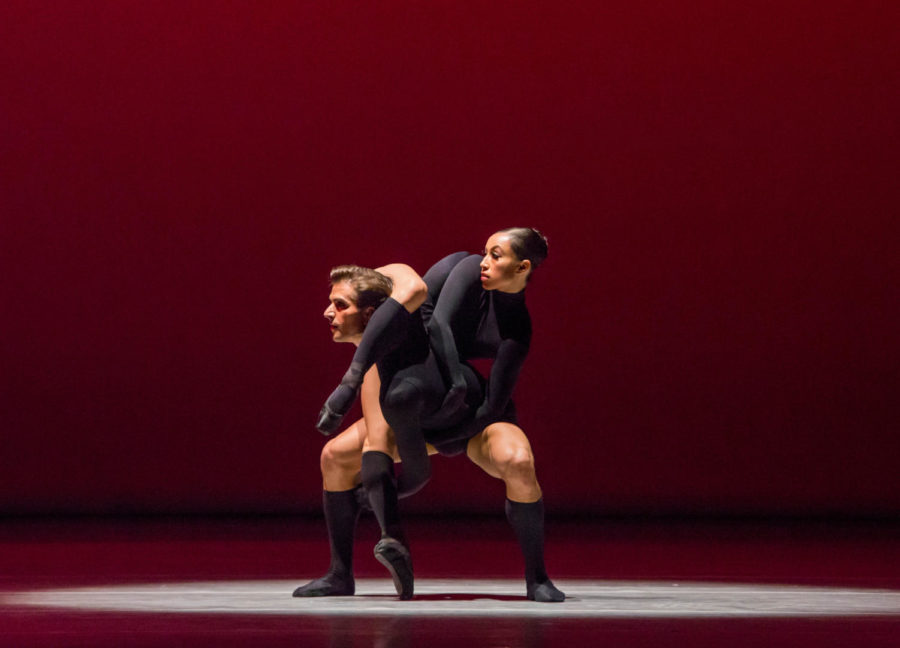A leather corset with hot pants. Nude spandex straight off the Yeezy runway with stilettos and monochrome bodysuits out of an American Apparel ad. With nary a tutu in sight, the Joffrey Ballet opened Global Visionaries last Wednesday evening: The program at Auditorium Theatre included the Chicago premiere of The Miraculous Mandarin, the world premiere of Joy, and a revival of Mammatus. The first of 10 performances, Global Visionaries celebrates modern choreography through an art form still heavily associated with the 18th and 19th centuries.
Resident choreographer Yuri Possokhov of the San Francisco Ballet adapted The Miraculous Mandarin from Béla Bartók’s 1918 score. The only narrative piece of the performance, its plot required a Wikipedia search during intermission: A gang of thugs sets up a honeypot trap with their female member (Victoria Jaiani) to fleece unwitting men. After a number of penniless targets, she lures in a wealthy Chinese mandarin (Yoshihisa Arai). Undeterred by the loss of his valuables, the mandarin continues to pursue the girl as her accomplices deter him with escalating violence. They eventually string him up on a noose, but the girl has second thoughts and cuts him down. They dance together before he collapses on her lap, like Michelangelo's Pietà, dead.
The Chicago Philharmonic sat on stage, performing a score that was at times tense and roiling with prominent brass and frantic drums. The staging was minimalist: a large steel-frame cube used as the setting of the girl’s beckoning performance and three heavyweight ropes hanging from the ceiling around which the thugs twined themselves. Jaiani was a sinuous dancer, limply tossed around by the gang members with a hidden coiled defiance. The final duet with Arai was energetic as the two moved in each other’s negative spaces like yin and yang.
Joy—titled Episode 47 until the morning of the performance—was created by Alexander Ekman in collaboration with Joffrey. A dismembered voice (presumably Ekman’s) preceded the dancing, asking, “What creates joy?” As the dancers hopped on their hands, skipped, somersaulted, and moonwalked on to the stage, the voice continued: “Can you see the dancers truly feeling joy? Or the ones who’ve had a shit day and must dance joyfully?” The stage was bare with the exception of a single tree, and a high ceiling bathed in bright white light evoked a feeling of endless space—an Eden where self-consciousness had not yet been discovered.
A giant flamingo light hung suspended in the air as a female dancer, soon joined by half the cast, declared, “This is a shoe drop” and dropped her pointe shoes noisily. The music—a mélange of blues, psychedelic club, and pop—floated in as the dancers moved across the stage in unison, leaping, stomping, and rolling on the floor. Stilettos dropped from the ceiling, and the dancers clomped around the stage in heels, thrashing spastically. There was an unbridled freedom to it all—the greedy joy of fully inhabiting one’s body. It was hyperbolic and over-the-top and campy, but discernibly self-aware. Above all, the joy was contagious as the audience laughed along and gave a standing ovation.
The final piece, Mammatus, is named after an opaque cloud formation associated with severe thunderstorms. Choreographed by Annabelle Lopez Ochoa, the precise lines of movement were matched onstage by a branch-like light installation and a simple, colored screen. Imbued with a subtle fierceness, the dancers moved in near-perfect synchronization with controlled purpose. The storm gathered strength as the throaty violin and electronic beep slowly came to a crescendo. The dancers, in black-gloved leotards, massed as a dark thundercloud with a moody red background. Release later came as a white-clad pair performed a duet, clinging to each other as the music softened. Like the sweet smell of rain after the storm, the two moved in delicate harmony, accompanied by the humming whoosh of the wind.
Classical ballet, with its clearly defined positions and delicate strength, is a study in carefully calibrated control, a constructed artifice of precise pirouettes and grand jetés. Although somewhat uneven in execution across the program, Global Visionaries showed the breadth of the Joffrey’s range and the possibilities of the human body’s expressivity.









